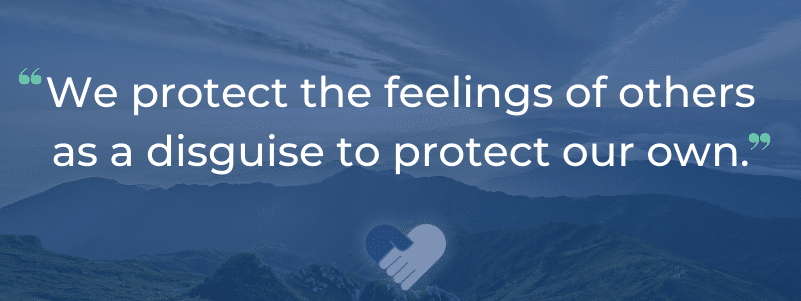What is an Intervention?
Intervention is a commonly used term among addiction and mental health professionals. Most people think of an intervention as something you see on television. Others may believe it is a simple conversation and confrontation to call the substance user out.
In this blog, we’ll cover the following:
- How is intervention defined?
- What is an intervention?
- How do you start an intervention?
- When is the best time to do an intervention?
- What is considered a successful intervention?
- What happens after the intervention?
- What happens if our loved one says no to treatment?
- What happens if our loved one says yes to treatment?
How is an Intervention Defined?
An intervention is a specific strategy used to meet a specific goal to address a problem or behavior. For example, if the problem were a lack of knowledge about how addiction and mental health affects the person and a dislike for the twelve-step program, then the behavioral goal would be to educate and change the person’s perception of both subjects.
The intervention strategy could be providing education, performing a payoff matrix exercise to see the advantages and disadvantages of substance use, and taking the person to various forms of 12 Step meetings. In reality, there are multiple intervention strategies that clinicians can use to achieve the desired goals to address the client’s needs.
The definition of intervention in the Merriam-Webster dictionary is The act or fact of taking action about something in order to have an effect on its outcome. The definition of intervention in Oxford Languages is Action taken to improve a situation, especially a medical disorder.
An intervention is an act initiated by a professional interventionist in conjunction with a substance user’s family members and loved ones. It aims to educate, create self-awareness, and alter unhealthy behaviors to encourage positive change for all affected.
Looking above at the definition of intervention, you must consider the task. You have a volatile situation in which you have an unhealthy family system sitting in the same room with the substance user, who often feels it is everyone else in the room’s fault for their current situation.
What is an Intervention?
You may or may not have an alcoholic or addict in denial. You almost always have a family in denial or unaware of how their actions have affected the situation. Furthermore, you have an alcoholic or addict who has not yet surrendered to treatment or successfully addressed their mental health, alcoholism, and drug addiction, so we must look at why. For starters, let’s look at
What is NOT an intervention:
- An intervention is not a 12-step call.
- It is not a motivational speech.
- It is not an ultimatum.
- It is not about bringing someone in who will just identify your enabling and talk your loved one into treatment. If that is your goal, that is a free service that most Alcoholics or Narcotics Anonymous members would be happy to help you with.
- Interventions are not about shortcuts or kicking the can while having continuous conversations with the alcoholic or addict, begging and pleading with them to stop using the substance.
- Interventions are not just getting them to go to treatment while the family sits home anxiously awaiting successful completion.
- Interventions are not about getting your loved one back home to feed your enabling, codependency, and unhealthy family role.
- An Intervention is not about how to control the substance user; it is about how to let go of believing you can.
In addition to learning how to let go of believing you can control the substance user, let’s look at
What an intervention is:
- Teaching the family how to communicate with the alcoholic or addict and each other effectively.
- Addressing the family roles that have prevented the alcoholic or addict from seeking help.
- Addressing the family roles that have prevented the family from seeking help for themselves and the alcoholic or addict.
- Identifying behaviors that comfort and worsen the addiction.
- Helping the family understand that their frustration is not solely with the substance user but with other family members too.
- Guiding families in their own recovery whether or not the alcoholic or addict enters rehab for themselves.
- Providing families closure that regardless of the outcome, they feel they have done all they can to prevent further destruction and have offered their loved one help.
The alcoholic or addict has a right to be a substance user, and the family has the right not to support them. How often have you heard an alcoholic or addict say they are of legal age and have the right to do whatever they want? They would be correct in their statement, and so would the family if they were to say and believe the same thing.
Alcoholism and drug addiction are often referred to as victimless crimes because they primarily affect only the substance user. If this were true, the family would not feel how they feel, and the substance user would not seek to inflict pain on the family while trying to make the family believe it is all their fault for the way things are.
When performed professionally and correctly, an intervention is about addressing the family system and offering the alcoholic or addict help. When you look at how alcoholism affects a family system, you will see that an intervention is much bigger than just getting the substance user into treatment. It is about starting the road to recovery for them and their family.
How Do You Start an Intervention?
The answer to this question is to let your professional intervention team explain how they are going to do that. In other words, do not start one without a professional; that’s the first step.
Interventions involve many moving parts, and there is no specific answer to give regarding how to start an intervention. It depends on the substance user, mental health considerations, location, patterns, current state, family, etc. This is why it is so important to use an experienced professional. They can collaborate with their team prior to coming out to meet the family and then collaborate with the family on the best strategies and protocol.
For example, you’re most likely not going to start an intervention in the home of a methamphetamine user with mental health disorder symptoms held up with guns actively using unless it is the only option. You must strategize to get the substance user to the safest and most comfortable location for everyone involved in order to start the process and get the message across effectively.

Any interventionist, who is honest anyway, will tell you that no matter how many interventions they have done, there is always an element of anxiety about how the substance user is going to react when they walk in the room. Sometimes you are met with anger, and sometimes you are met with tears.
Regardless of who walks through the door, the family would be in the best position possible if they had an experienced professional intervention guiding them and diffusing any volatility that may arise. Remember, the substance user has issues with most people in the room.
An interventionist poses as the person the addict or alcoholic has the fewest issues with. They may take their anger out on the interventionist and the interventionist, and on occasion, certain family members who do not appear as a threat to the substance user are best at handling the start of the intervention as well as the follow-through.
Read More: How to Live With an Alcoholic or Drug Addict
In most cases, after getting the substance user to sit down, the professional interventionist starts the intervention with an introduction. This is all based on case notes and feedback during the family day. In other words, an interventionist has a professional strategy; they aren’t just winging it.
Once we have the attention of the substance user, the interventionist acting as a mediator will ask family members to read their letters. There is a strategy to this, too, and who reads what and when matters. After the letters are read, the interventionist starts to work on the substance user. The interventionist often has to handle objections as well as anger.
All of this has been discussed at the pre-intervention meeting, also called the family day. The family should be prepared and see what is unfolding based on what they have learned thus far. From your initial call to that moment, you’re in the intervention, you have been learning about what is going to happen and why.
The substance user will either accept help, or they will refuse. The interventionist will guide you regardless of the outcome and provide you with the next steps of the ongoing support process and the Family Recovery Coaching. The intervention is not an event; it is a process. It is not over because they refused help, and it certainly is not over if they accept help.
When is the Best Time to do an Intervention?
Some have different opinions on the best time to do an intervention. The reality is it is impossible to perfectly time the volatility of the substance user. Families always look for that magical moment; besides a few circumstances, there really isn’t one.
Two magical circumstances that are not always an option are when the substance user is incarcerated or hospitalized. In either of these two situations, you have the best opportunity because the addict or alcoholic is not on drugs or alcohol, and they can’t justify that they are or were doing well.
Read More: How to Talk to a Drug Addict About Seeking Help
Some professionals suggest waiting until the substance user abstains from drugs or alcohol before intervening. This is a bad idea outside of abstinence caused by incarceration or hospitalization because if the substance user is free from drugs and alcohol, they will tell you they don’t need help because they are clean. When they come out of jail or a hospital you have them somewhat clear-headed and they cannot justify they are doing well given where they just came from.
Aside from these two scenarios, a substance user can fight the intervention and plead their case if they are drug or alcohol-free. It is much more complicated if the only reason you are abstinent is that you were recently arrested or hospitalized for mental health and substance use-related concerns.
If you wait for that magical moment for them to be substance-free, you will be waiting a long time. Who is to say they won’t be drunk or high by the time the interventionist arrives?
Addiction is more about the behaviors and mental health than it is the substance use yet a substance user always wants to make it about whether they have used substances as does their family.
If a family is calling for an intervention, when the interventionist arrives, they will almost always go to see the substance user in one of two states: drunk or high or sick from not being drunk or high. If they have detoxed themselves outside of a jail or hospital the intervention will be more difficult than if you intervene when they are actively using.

Interventions are always about intervening in mental health concerns, destructive behaviors, and lifestyles. It would appear that we are intervening in the substance use and the substance use in and of itself is not why families call nor why people seek help.
Waiting for the substance user to be clean and sober first misses the mark on the addiction problem and what an intervention seeks to accomplish. A family should intervene when they call inquiring about needing to intervene.
The best time to intervene is when you know something has to change. Families should not be waiting to intervene when it is convenient for the substance user. Families should intervene when it’s convenient for them.
“Whenever you feel the need to protect the feelings of another person, you are only seeking to protect your own.“
What is Considered a Successful Intervention?
The success of the intervention is determined by the goals set at the intervention. Families often refer to intervention as failed when the substance user refuses help. Some families refer to it as failure, even when their loved one accepts help.
Because of this, some of the things we look at to determine an intervention’s success is how much the family learns to change their outlook and perception and engage in our family recovery coaching program while reducing their reactivity to the substance user.
If the family is hiring the intervention company just to get their loved one into treatment, then the success rate will be determined by whether they go. If the family hires the interventionist to regain control of the situation and their loved one, they will not be happy, nor will they consider it a success if the person accepts help and gets better.
This is why we put so much emphasis on behaviors and mental health over substance use. You do not need to be on substances to act like you still are. Families have as much volatility, uncertainty, anxiety, and distorted perception as the substance user does.
If the intervention does not address the family system and move them into recovery, then any success by way of the person going to treatment is often short-lived. We are not saying that drugs and alcohol are not a concern or an issue.
The use of substances causes many problems, including medical and mental health concerns. The point being made is that drugs and alcohol use cause harmful behavior as much as emotions, feelings, and behaviors start the drug and alcohol use.
Unresolved trauma, the family of origin problems, horrification, perception, mental health, emotions, and behaviors lead to self-medication. These behaviors in both the family and the substance user do not disappear because the substance user enters a treatment center, in fact, they get worse before they get better.
To think an intervention is successful because someone went to treatment would be to believe you fixed the dam because you put some tape on it. Families get far angrier and more reactive after the intervention and even more so when the person accepts help.
The substance user gets more manipulative and angrier after they accept treatment. The turbulence after an intervention is far more work than the intervention itself. Doing an intervention yourself or hiring a solo interventionist does not address these problems that will arise.
One of the most important things about what is considered a successful intervention should be the family knowing they did everything they could to stop it and enter recovery for themselves.
For more insight into what is considered a successful intervention, please visit our resources to learn more.
What Happens After the Intervention?
A common question and concern families want to know is what happens after the intervention. The answer will vary depending on whether the person accepts help. Regardless of the outcome, there are many goals and similarities.
The first and most important thing after the intervention is that the family receives support and moves into their recovery program. Family First Intervention has a full continuum of care for our families. From the consultation to the Family Recovery Coaching.
Whether or not the families receive the results they were hoping for, they are encouraged to continue working through our intervention manual with our Family Recovery Coaching Counselors to receive our ongoing support and guidance.
This curriculum is called S.A.F.E.™ Family Recovery Coaching. S.A.F.E.™ is an acronym for Self-Awareness and Family Education™. One of the most important quotes on our website, something you have read in this article more than once, is:

One of the most important outcomes we can hope for during an intervention is that the person accepts help and the family is happy.
Although nobody has direct control over the substance user, families have much more control over their own actions that allow certain behaviors and entitlement within the substance user.
Where the power lies for families is within yourselves and how you accept the outcome while changing your perception through ongoing education and recovery.
Learning how to live and communicate with an addict or alcoholic in your life and to reduce your reactivity, whatever the outcome, is one of the many end goals of our program.
Families struggle just as much when their loved ones accept help as they do when their loved one refuses help, and for different reasons.
Many would think that refusal of treatment would be most challenging for the families, and for some, it is. Both outcomes bring their challenges, and we will do our best to explain those challenges below.
What if our Loved one says “NO” and Refuses Help or Treatment?
When treatment is refused, and the addict or alcoholic says no, we move into the treatment refusal phase.
Our Family Recovery Coach, that handles the treatment refusal interventions, sets an appointment with the family to start the process of aftercare and support. The interventionist at the intervention who is present regroups with the family to strategize if there’s anything else that can be done and discusses the next steps.
What is interesting about a treatment refusal is that families are not nearly as upset as those whose loved ones accepted help which we will get to in the next section.
Treatment refusals often sadden the family, yet they almost always have comfort that they did all they could. Families may not find this upsetting because a no is all they have ever known, and they hope they can now see and process the negative like they never have before.
After many years of having an addict or alcoholic in the family, it becomes the new normal, and anything different would be difficult, even if it is better.
We’re not saying families want to have their loved one say no. What we are saying is it is not new to them that their loved one refused treatment again and have learned how to live this way. In other words, change for the family is less and more familiar when their loved one refuses.
The positives that can come from a treatment refusal are family empowerment and family healing. When the addict or alcoholic says no, the family will most likely see things from a different perspective, having gone through the family preparation and ongoing family recovery coaching.
Learning about family roles, where anger is coming from and why, and who it is directed at allows families to work together rather than against each other. The family can use their new knowledge and perspective to hold their loved one accountable with boundaries providing the family is all on the same page throughout the process.
A no can allow a family to see that the addiction and mental health is not their fault, and if the addict or alcoholic refuses help, then it is on them and not the family that offered a solution. Refusing an intervention is not the end of the world.

Although we would love all our families’ loved ones to say yes on the first try, in our experience, no’s that turn to yes do better in treatment. This is because they almost always test their families’ boundaries and newfound approach until they surrender.
If the family lasts longer than the addict or alcoholic, their exhaustion carries into their treatment, and they don’t fight as hard to try and leave treatment in most cases.
Most substance users refuse help for two reasons:
- They don’t want to stop getting drunk or high.
- They are not done trying to hurt the people they feel are the cause of their problems and don’t believe the family will follow through with their boundaries and consequences.
When the addict or alcoholic puts the family to the test, and they pass, the substance user almost always surrenders and gives up the fight.
When the addict or alcoholic can no longer hurt the family the way they used to, it shuts down half of the driving force behind the addiction.
Substance users blame everyone and everything else for their problems and start with those who love them the most. Most have deep-seated resentment towards others in the family system and are on a quest to hurt and destroy those in the family either directly or indirectly. We believe nothing disrupts one’s next drunk or high more than a family no longer allowing the substance user to control them and destroy them.
When the family gets well and changes how they have been doing things, it allows a greater opportunity for the substance user to follow and get well themselves. Like attracts like; When the whole family is unwell, the substance user is in their element.
When the entire family gets better, it knocks the substance user off their square. They become solely accountable for everything that happens next, making their addiction far more uncomfortable than how it used to feel. This is part of the contemplation stage of change.
People do not make a change unless the current situation becomes more uncomfortable than the fear of doing something different. If nothing changes, then nothing changes. If you can’t change the substance user, change everything around them.
Families often ask, what if our loved one says no? What happens then? The real question isn’t what if they say no; it is what if they say yes, and then what happens to me?
“The most formidable challenge we professionals face is families not accepting our suggested solutions. Rather, they only hear us challenging theirs. Interventions are as much about families letting go of old ideas as they are about being open to new ones. Before a family can do something about the problem, they must stop allowing the problem to persist. These same thoughts and principles apply to your loved one in need of help.”
Mike Loverde, MHS, CIP
What Happens Next When our Loved one says “YES” and Accepts Help?
Most interventionists who only talk people into treatment would answer this question very simply. They will tell you after the substance user says yes, they will take them to treatment and say that you can call them with any questions. They may tell you that they will notify you after they drop off your loved one and for you to wait for your loved one to call or for someone from the center to call.
Many interventions rarely tell you the truth about how much volatility, anger, reactivity, and uncertainty the family will have. They will not tell you that they just took away the primary enabler’s purpose in life and that while they are in treatment, the primary enabler will get angry as they are driven by fear that they may no longer be needed in the relationship because of years of codependency.
They will not tell you how the Martyr and the Hero roles will call everyone and demand answers, trying to control the situation even after it is over. How they will call the treatment center nonstop for various reasons, all having to do with no longer feeling they are in control of the substance user. They won’t tell you this because they don’t know. Their only job was to ask you to stop enabling and talk the person into a center. They don’t know how to help you see the big picture and understand what has happened over the years.
A professional intervention company can help you with this, and if you don’t address it from this perspective, you will keep blaming everyone else for the substance users’ failures.
I will never forget the day I overheard my program director on the phone with his wife shortly after he arrived at the office on a Monday morning. The words that came out of his mouth are something I will never forget. It was not only true, but it was also something I had been teaching him and something I knew he had to repeatedly witness time and time again to believe it. He said to his wife, “I will be home late tonight. We had 9 successful interventions over the weekend, and families are going to be upset”. Most people, clinicians included, do not believe that a family has a more challenging time with a yes than with a no.
The family has a choice when the substance user says no and refuses treatment at the intervention. They can stay the course in their dysfunctional family role that they have adopted and utilized as a maladaptive coping strategy. The other choice is they can change everything and forge ahead with what they have learned and allow their family system to balance back to a healthy state.
When the substance user says yes, the family doesn’t have that choice, and the family dysfunction will almost immediately come to light with the substance user away in treatment and no longer to blame.
The family system will start to go back to normal. When the dysfunctional family system fights the shift back to health, fear-driven anger comes out at us and the treatment center in several ways because the family has no idea where the anger and frustration are coming from.

Until the intervention, the family never considered the problem was the family system adapting and shifting to cope with the addiction and mental health.
The addiction and mental health is not the family’s fault, and neither is the shift to dysfunctional family roles. It happens instinctively, and it is inevitable it will happen.
Most families don’t even know why they are doing it or why it is shifting. They never realized that their resentments were with the primary enabler who gave all their attention to the substance user, and as a result, their relationship with the primary enabler suffered. This is why so many marriages go bad when an addiction and mental health is present.
One parent usually puts all their attention on the substance user. The other spouse doesn’t like it because they know it isn’t helping the substance user, or so they think. What they don’t often see is their resentments are more about the lack of attention to the other spouse than all the enabling and attention to the substance user.
Once the substance user is gone, the primary enabler is lost with what to do next, and the other family members no longer can blame the substance user for their unhealthy family role. They often resent their spouse and others for having a hand in making them do the intervention and taking their loved one or their purpose away from them.
The hero fights to keep the status quo of being the perfectionist and is either terrified the substance user will get better and steal their thunder or that they will not be recognized for all they did that contributed to the successful intervention.
The martyr will behave like a victim and place the attention on them. The other family roles will struggle as they find their way home to a rebalanced and healthy family system. The good news is that everything can get better and will get better if everyone in the family starts working on their own recovery and starts addressing these concerns.
This may sound scary and like a lot of work, but it is much easier to go through the intervention and start the healing process than to stay in the destruction and fight it.
“After the intervention, family members fight each other as if they are saying, look at what you made me do. I was comfortable in my unhealthy role, and now I have to look at myself, and I can no longer blame the addict or alcoholic”.
If You’re Asking, “When is it time to do an intervention?” the Time is Now
When you think about it, the alcoholic and the addict will try and do anything other than the one thing that can help them seek help and go to treatment. Families do the same thing. They go about fixing the problem in every possible way other than hiring a professional and addressing their broken family system.
Both the substance user and the family will sound hundreds of different excuses fueled by misplaced emotions and distorted perceptions. The least qualified people to solve the problem and navigate every avenue other than the solution that yields results.
Both family and substance users do not do this on purpose. They follow this path based on emotions and flooded judgment. The substance user makes decisions in their addiction and state of mental health, and the family makes decisions while consumed in the chaos.
The best time to do an intervention is when you think your loved one needs help and they are not seeking it. If they are not willing to do something about their problem, it doesn’t mean you can’t be willing to do something about it.
We must get away from this notion that they must want help or hit bottom. Almost every time the substance user does not wish to help and isn’t hitting the bottom because they don’t have to get help, the family or environment prevents the base from being felt.
Interventions are designed for families to learn how and why they have allowed the situation to get this far.
It is difficult to resolve a problem when you play a significant part in it. Interventions benefit families by making an impact and drawing attention to the situation in a different way from what has been done in the past. We know that the substance user is going to have an intervention at some point. The family can choose when that happens before it is imposed on the loved one. Understanding which behaviors have been helpful and which have been counterproductive allows the substance user to be held accountable and to see the need for change. The substance user is going to make a choice as to what to do. The family is the only one with both a clear choice and the ability to make a rational change. The substance user is most likely not going to change because of a speech; it almost always requires a change to the environment that has been an impediment to change. This environment is the family system that often reacts counterproductively to the substance user. Intervention can benefit a family by taking the first steps with the likelihood that the substance user will follow through with change, too.
Connecting with a Professional Interventionist
At Family First Intervention, we understand the heartache that addiction and mental health causes a family. Some families may have forgotten what life used to be before the addiction and mental health concerns took over. Others may not believe they can get back to a healthy way of living, but families can recover just as a substance user can. Like the substance user who tries to fix, manage, and control the addiction and mental disorder but to no avail, the family also fails to fix, manage, and control the substance user.
Family First Intervention has helped thousands of families achieve their goal of taking back their lives and beginning their own recovery program. It is OK to think about and at times be concerned with your loved one’s actions. It is not OK to be overwhelmed with the chaos and confusion by attempting to control his or her actions.



